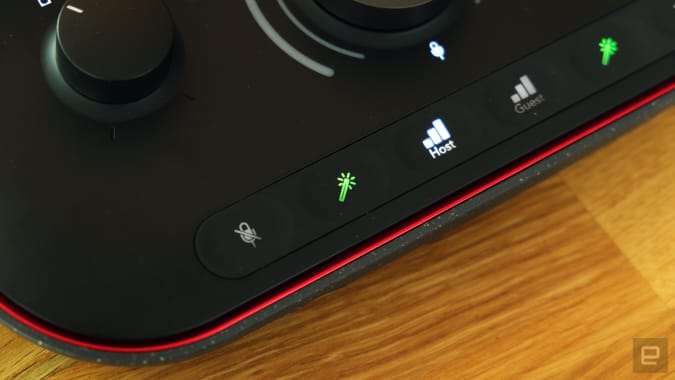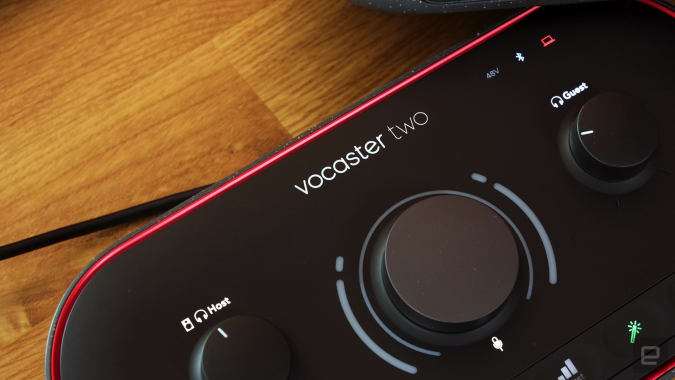Focusrite Vocaster hands-on: Streamlined audio interfaces built for podcasters
Focusrite already makes some of the most popular audio interfaces on the market. If you’re a budding musician or bedroom producer, you’ve probably considered one of their Scarlett interfaces when building out your studio. They’re also great options for podcasters. But music producers and podcasters have different needs and priorities, so Focusrite is specifically targeting the latter with its new Vocaster One and Vocaster Two. These new interfaces have a handful of features aimed at making the lives of podcast hosts and streamers much easier.
The two interfaces are largely the same, it’s just that the Vocaster Two has two of everything, while the One has… you guessed it, one. There’s two mic inputs and two headphone outs on the Vocaster Two, and just one on the other. The ins and outs are also handily labeled as “host” and “guest” rather than simply “one” and “two.” That means you can probably set the host channel the way you want it and never worry about it again.
Terrence O’Brien / Engadget
Both Vocasters have large knobs on the top that make controlling mic gain and headphone levels easy. But there’s also an array of buttons below that offer quick access to extremely useful features. There’s a pair of mute buttons, an auto gain feature for setting mic levels automatically, and an Enhance button that applies compression, EQ and highpass filter to instantly improve the quality of your voice. While the button on the interface itself simply turns Enhance on and off, in the Vocaster Hub app there are a few different presets to select from. Radio and Clean are my two favorites, but Bright and Warm might work better for some depending on the tenor of their voice.

Terrence O’Brien / Engadget
You’ll definitely want to install the Vocaster Hub app. While the interfaces will work right out of the box with no additional software, there are advanced features hidden in the app and it just makes some tasks that much easier. For one, it’s the only way to manually set the level of both mic inputs independently on the Vocaster Two. While you can use the auto gain on both from the device itself, there’s only one gain knob and it controls both inputs simultaneously.
The app is also where you can control the levels for the two loopback channels and the aux input. The loopback makes it easy to pipe in theme music while the aux input is handy for having guests dial in. It is worth noting, though, that to take full advantage of that you’ll need a TRRS to TRRS cable, a regular audio cable won’t cut it. But this ensures that not only can you hear your guest, but they can hear you as well.
The more expensive Vocaster Two not only has an aux input, but also Bluetooth connectivity for bringing in guests wirelessly, but I’d be hesitant to trust that myself. There’s already enough things that can go wrong when doing remote interviews that I wouldn’t want to add Bluetooth to the mix.

Terrence O’Brien / Engadget
Both interfaces have left and right audio outs for connecting studio monitors, but the camera out is probably more useful for the intended audience. It’s really just a standard 3.5mm TRS stereo out, but if you connect it to a camera you can avoid having to sync up audio after the fact on a vlog, and instantly step up your streaming game. There’s 48v phantom power if your preference is for condenser mics.
In my brief testing both interfaces worked as advertised. For someone just getting started in podcasting, or who wants to be as mobile as possible, these would make a ton of sense. The Enhance feature works wonders and it does so with no fuss. It’s similar to the Air feature on the Scarlett line, but tuned much more specifically for the human voice.

Terrence O’Brien / Engadget
The auto gain also worked fairly well, quickly allowing me to swap microphones without spending a ton of time dialing in gain manually. It might be a tad conservative for some, but it’s easier to make things louder in post if necessary than it is to clean up a clipping mic.
The plain aesthetics and plastic build are nothing to write home about, though. The only flourishes are the LED ring around the gain knob and the red accents around the edges. But frankly, one of the least important things about an audio interface is how it looks. I might not toss these haphazardly in a bag, though. Some thoughtful cushioning is definitely necessary if you’re taking these on the road.
For all the latest Technology News Click Here
For the latest news and updates, follow us on Google News.
